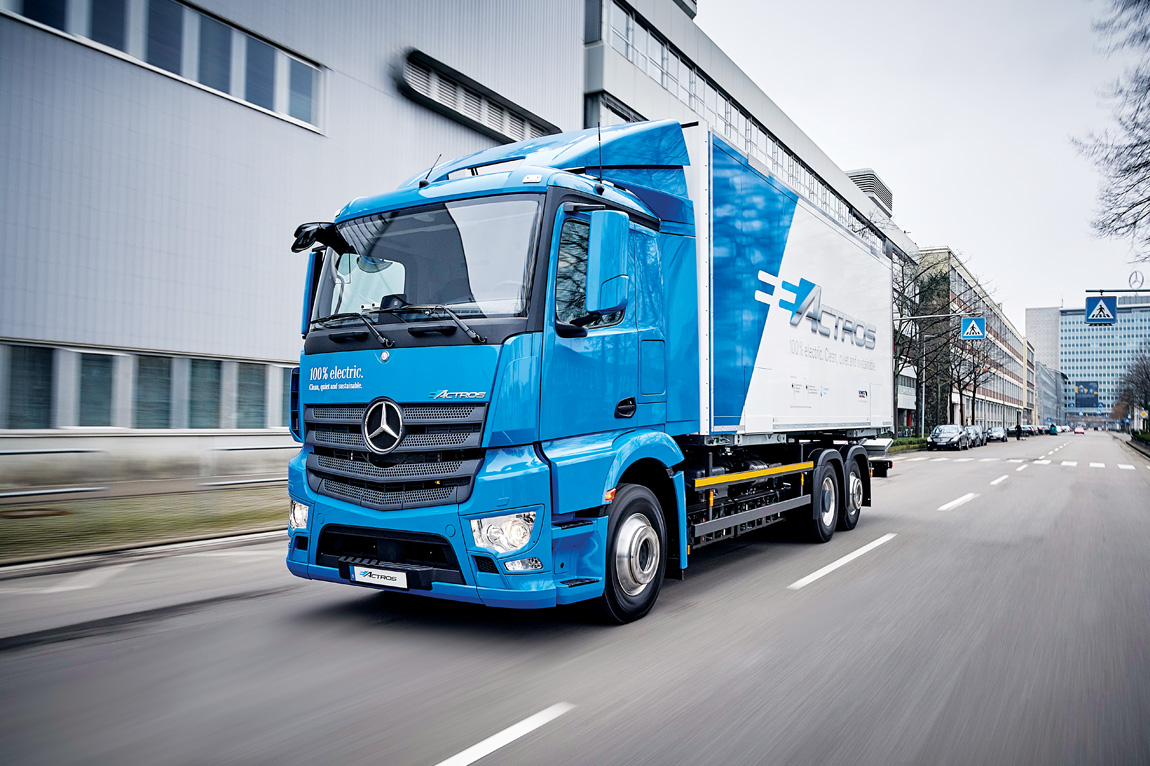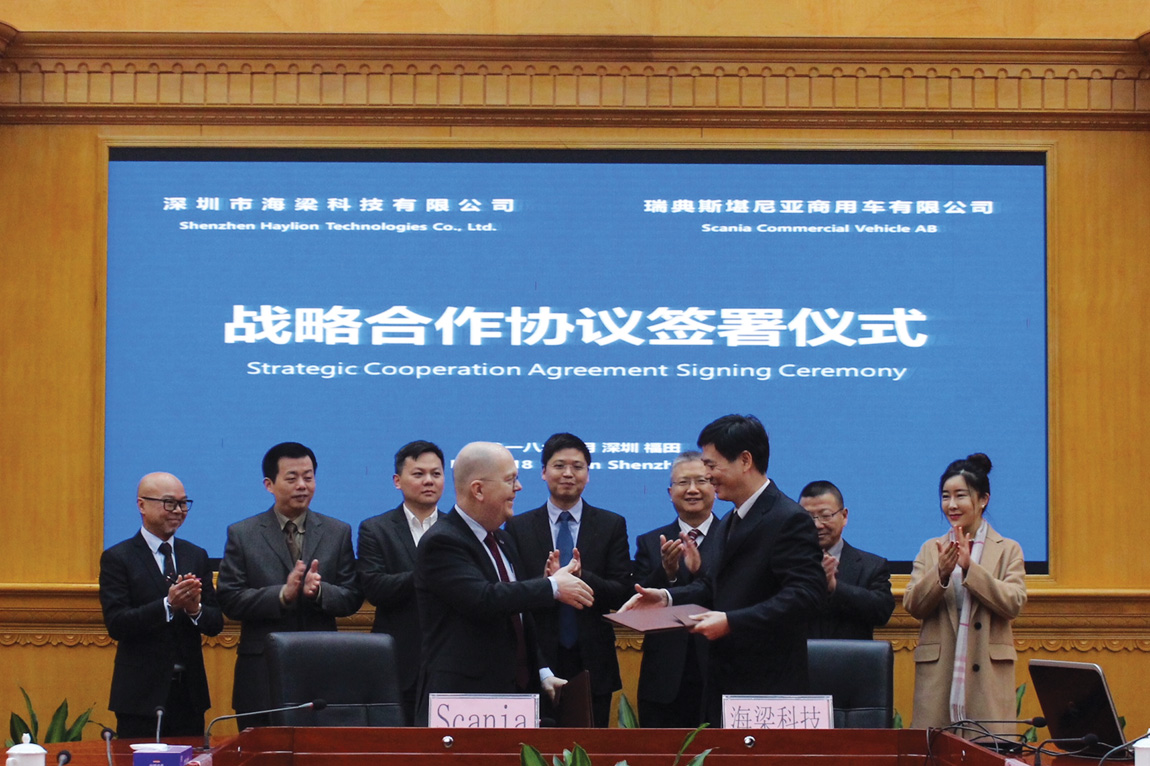All-electric Actros makes its debut and Scania also heads down Electric Avenue

Mercedes-Benz has pulled an electric rabbit out of its hat! The company has lifted the lid on the eActros, which, as its name implies, is a fully electric heavy-duty truck. I must say that I was surprised at the launch. While I knew that MAN was working on bringing an electric truck to market (we’re expecting it within months); the Mercedes-Benz team was very hush hush about its developments.
This is not to say that the company has been snoozing when it comes to electric trucks. In fact, back in 2016, Mercedes-Benz Trucks became the first manufacturer in the world with a heavy-duty electric truck. I wrote about it extensively. However, it was a concept vehicle only.
Now the company is producing trucks that are being delivered to customers – and I must say that the eActros looks very impressive. Ten vehicles, with a gross vehicle weight of 18 or 25 t, will be handed to German and Swiss customers within the next few weeks.
They will be testing the eActros in everyday operating conditions. These are the companies that are participating in the test (they’re all household names in Europe): Dachser, Edeka, Hermes, Kraftverkehr Nagel, Ludwig Meyer, pfenning logistics, TBS Rhein-Neckar and Rigterink from Germany, and Camion Transport and Migros from Switzerland.

The truck is obviously based on a regular Actros, but the vehicle architecture has been configured specifically for an electric drive system. The drive axle, for example, is based on the ZF AVE 130 that has already proved its worth as a low-floor portal axle in hybrid and fuel-cell buses from Mercedes-Benz and is now being fundamentally revised for the eActros.
The drive system comprises two electric motors located close to the rear-axle wheel hubs. These three-phase asynchronous motors are liquid-cooled and operate with a nominal voltage of 400 volts. They generate an output of 125 kW each, with maximum torque of 485 Nm each. The gearing ratios convert this into 11 000 Nm each, resulting in driving performance on par with that of a diesel truck.
The maximum permissible axle load stands at the usual 11,5 t. The energy for a range of up to 200 km is provided by two lithium-ion batteries with an output of 240 kWh.
The batteries are accommodated in eleven packs, all in all: three of these are located in the frame area, the other eight are to be found underneath. Discharged batteries can be fully recharged within three to 11 hours, assuming a realistic charging capacity of 20 to 80 kW from a mobile charging device at a fleet depot.
The trucks will be fitted with refrigerated box bodies, tankers or tarpaulin sides – depending on customer requirements. They will be tested for 12 months. Then, in one year’s time, a second round of testing (yet another 12 months) will commence. As such, the Mercedes-Benz team will be gathering a lot of data and feedback along the way, and presumably tweaking what will become the production version. Series production is planned by 2021.
Scania also heads down Electric Avenue
In a similar vein, Scania has announced a new collaboration with Haylion Technologies, which focuses on solutions for the Chinese transport industry in the areas of autonomous driving, electrification and connectivity – specifically within public transport.

“For Scania, this partnership provides unique opportunities to contribute to, as well as to learn from the rapid technology development now taking place in China in these strategic areas. We look forward to combining our knowledge and global perspective with the expertise and ambitions of Haylion Technologies,” Mats Harborn, executive director of the Scania China Strategic Office, tells FOCUS.
The two companies will be working towards the commercialisation of autonomous driving applications and sustainable transport.
“Gaining excellence in skills through collaboration has always been our principle. We recognise Scania’s leading position in the world’s commercial vehicle industry. I believe that our cooperation will further promote and accelerate China’s development of intelligent vehicles and the Internet of Vehicles (IoVs),” says Dr Jimmy Hu Jianping, founder and chairman of Haylion Technologies.

Dakar winner says hi!
Eduard Nikolaev is clearly a very talented driver. He romped home to victory in his Kamaz in January, after leading the race for all but two days. He’s also a nice chap. He recently sent this signed photograph to all the members of the International Truck of the Year jury (of which FOCUS is a part). Isn’t it nice?
MAN goes platooning
Team MAN is obviously still working on its electric trucks. However, like most other manufacturers, it’s also working on platooning. And the latest news in this regard is that it has handed vehicles to DB Schenker, so that the company can test platooning on a day-to-day basis. According to MAN, this is the first time that networked trucks are being put into practical use in the logistics industry.

DB Schenker and MAN will be working with Hochschule Fresenius in a research project to test networked trucks in daily logistics operations. It is widely believed that autonomous and networked driving will fundamentally change road haulage in the not-too-distant future.
The trucks will run on Germany’s A9 freeway between Munich and Nuremberg. Hochschule Fresenius is providing the scientific support for the test drives, and it will study the impact of the new technology on the neurophysiological and psychosocial levels of the drivers.
South Africa is not alone
Moving from something very nice to something rather nasty, it seems that South Africa is not alone when it comes to crime related to trucking. According to the Transported Asset Protection Association, cargo to the value of €1,3 billion
(R19 billion) is being stolen each year in Germany.
According to the association, 26 000 trucks are targeted each year. On average, there is a new attack on a truck every 20 minutes. In addition to the value of the goods, the group says further damages of €900 million (R12,8 billion) are caused by penalties for delivery delays, the cost of replacing stolen products and repairing damage to vehicles targeted by cargo thieves.
So, we are most definitely not alone in our cargo theft woes.
A rubbish event?
I’ve always believed that the Brits are barking mad – and now I can prove it. They’re awaiting – with anticipation, I do believe – the start of the National Refuse Championships, which will take place in Weston-super-Mare on June 15 and 16 this year.

The first-ever National Refuse Championships took place in June 2017 – and it saw over 100 refuse vehicle drivers and loaders from across the United Kingdom compete in a series of races. The participants form teams, who run, load a large wheelie bin with sand and then push it 50 m to an awaiting truck to empty it. This gruelling process is repeated numerous times, as the truck moves in 50-m stages towards the finish line.
It’s all for a good cause; over £12 000 (R195 000) was raised for the Alzheimer’s Society last year. The event is organised by a company called Refuse Vehicle Solutions (RVS) – a supplier of refuse vehicles.
Last year’s event was won by the Aylesbury Vale District Council, which is currently preparing not one, but two teams, to defend its title as National Refuse Champion. Demand from the council’s female loaders and drivers, means that they will have their own team.
Fascinating facts
Finally, here are some fascinating facts to end this column. I received these facts recently in a media release issued by the InnoTrans trade fair. They do relate to trains (which is not really our market), but I think that they’re really interesting – and so I decided to share them with FOCUS readers.
In Japan, it takes a mere seven minutes to clean the entire Shinkansen bullet train. In Austria, train toilets are decorated with photographic wallpaper and fragrant aromas. In Switzerland, digitisation is on the march, with robots being used to clean station floors. And, in Germany, customers can use WhatsApp to provide the railway operators with up-to-date details about areas that require cleaning. Howzat?!
Published by
Charleen Clarke
focusmagsa




